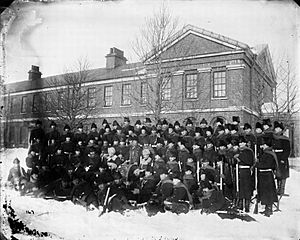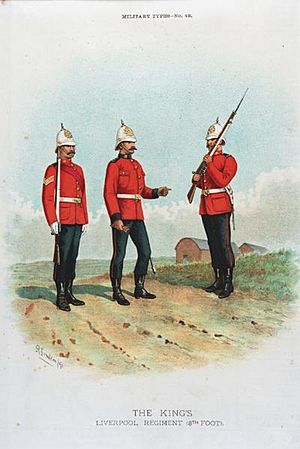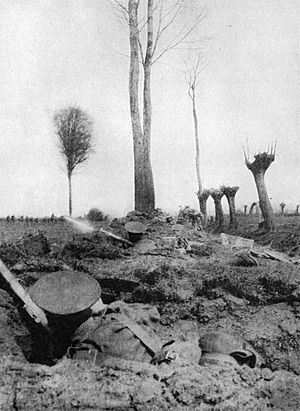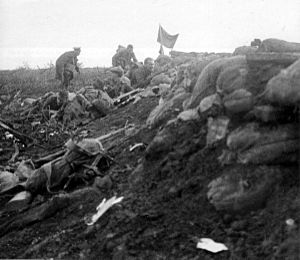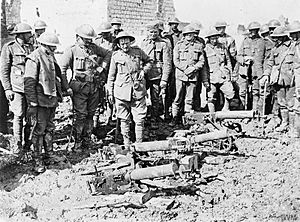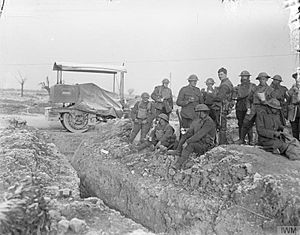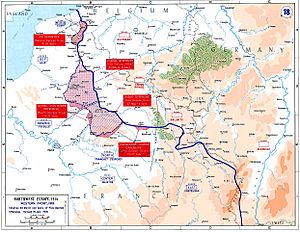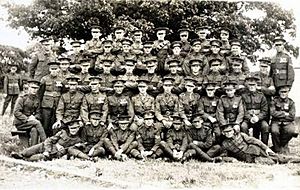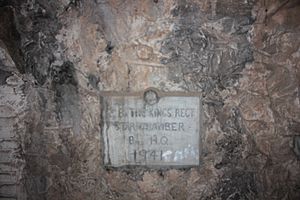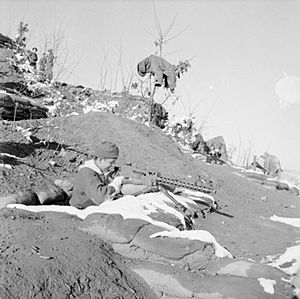King's Regiment (Liverpool) facts for kids
Quick facts for kids King's (Liverpool Regiment)King's Regiment (Liverpool) |
|
|---|---|
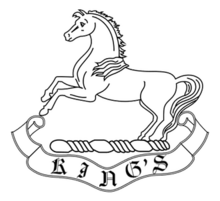
Cap badge of the King's Regiment (Liverpool), showing the White Horse of Hanover.
|
|
| Active | 1 July 1881 – 1 September 1958 |
| Country | |
| Branch | |
| Type | Line infantry |
| Size | Varied; see full list of battalions |
| Regimental Depot | Warrington (1881–1910) Seaforth (1910–1958) |
| Nickname(s) | The Leather Hats, The King's Hanoverian White Horse |
| Motto(s) | Nec Aspera Terrent (Difficulties be Damned) |
| Colours | Blue |
| March | Quick March: Here's to the Maiden Slow March The English Rose, |
| Anniversaries | Somme (1 July) Blenheim (13 August) Delhi (14 September) |
| Engagements | First World War Russian Civil War Anglo-Irish War Second World War |
| Commanders | |
| Colonel-in-Chief | King George V (c. 1925–1936) |
| Colonel of the Regiment |
Brigadier Richard Nicholas Murray Jones (1957–1958) |
The King's Regiment (Liverpool) was a very old regiment (a large group of soldiers) in the British Army. It was formed in 1685. Unlike most British Army regiments, which were linked to a county, the King's Regiment represented the city of Liverpool. It was one of only four regiments in the British Army connected to a specific city. After being around for 273 years, the regiment joined with the Manchester Regiment in 1958. They formed the King's Regiment (Liverpool and Manchester). Later, this new regiment also joined with others to create the current Duke of Lancaster's Regiment (King's, Lancashire and Border).
The King's Regiment fought in many important conflicts. These included the Second Boer War, both world wars, and the Korean War. During the First World War, the regiment sent many groups of soldiers, called battalions, to different battlefronts. These included the Western Front in Europe and other areas. More than 13,000 soldiers from the King's Regiment died in this war. In the Second World War, some battalions landed during Operation Overlord (D-Day). Others fought as special forces called Chindits in Burma. The 2nd Battalion served in Italy and Greece. The King's Regiment also fought in the Korean War, which was its last major conflict.
Nine Victoria Crosses were given to soldiers from the regiment. This award is the highest honor for bravery in the British military. Two more Victoria Crosses were given to Royal Army Medical Corps officer Noel Godfrey Chavasse. He was a doctor attached to the 10th (Scottish) Battalion during the First World War.
When there was no war, the regiment's battalions were based in the United Kingdom and in British colonies around the world. Their jobs included stopping riots in places like Belfast and the Middle East. They also guarded military bases in areas like the North-West Frontier Province and West Germany. They also took part in parades and ceremonies.
Contents
Colonial Wars (1881–1914)
Between the 1860s and 1880s, the British Army was reorganized. Many smaller regiments joined together. The King's Regiment already had two regular battalions (groups of soldiers). So, it did not need to join with another regiment. However, on July 1, 1881, its two battalions became the 1st and 2nd Battalions, The King's (Liverpool) Regiment. The regiment had been linked to Liverpool since 1873. Other groups of soldiers, like the militia and volunteers, also joined the King's Regiment. Nine of these groups from Lancashire and the Isle of Man became part of the King's.
After the 1881 changes, the regiment included:
- Regulars
- 1st Battalion
- 2nd Battalion
- Militia
- 3rd (Militia) Battalion
- 4th (Militia) Battalion
- Rifle Volunteers
- 1st Lancashire Rifle Volunteer Corps (became 1st Volunteer Battalion)
- 5th Lancashire (The Liverpool Rifle Volunteer Brigade) Rifle Volunteer Corps (became 2nd and 3rd Volunteer Battalions)
- 15th Lancashire Rifle Volunteer Corps (became 4th Volunteer Battalion)
- 18th (Liverpool Irish) Rifle Volunteer Corps (became 5th (Irish) Volunteer Battalion)
- 19th (Liverpool Press Guard) Lancashire Rifle Volunteers (became 6th Volunteer Battalion)
The plan was for one regular battalion to be in the UK and one overseas. In 1881, the 1st Battalion was bombed while in Salford, England. This attack was part of a campaign by Irish Republicans. The barracks had minor damage, but a child was killed. Soon after, the battalion helped stop riots during mineworkers' strikes. In 1882, the battalion moved to Ireland and helped with riots in Belfast.
The 2nd King's Battalion had been in India since 1877. It fought in the Second Afghan War. In the 1880s, it also fought in the Third Burmese War. Britain wanted to take control of Upper Burma. The invasion began in November 1885. The British quickly captured forts and the capital, Mandalay. The battalion helped escort the Burmese King Thibaw into exile. After Burma was taken over, a guerrilla war started. This lasted for at least five years. The King's soldiers operated in small groups, chasing guerrillas in the jungle. Many soldiers were killed or wounded. By early 1900, the 2nd Battalion was stationed in Gibraltar.
The 1st King's Battalion spent two years in Nova Scotia, Canada, starting in 1893. In 1895, they provided a 100-man guard of honour for the body of Canadian Prime Minister John Thompson. The battalion then moved to the West Indies and later to South Africa in 1897. The Second Boer War began two years later. Before the war, the 1st King's formed a company of soldiers who fought on horseback. They trained in Ladysmith, South Africa.
The war started on October 11, 1899. Boer forces invaded Natal. The British suffered heavy losses in early battles. They retreated to Ladysmith, where their main forces were. The Boers surrounded Ladysmith and placed cannons on the hills around the town.
On October 30, General White ordered an attack on Boer positions. The plan was confusing and failed badly. The 1st King's Battalion was part of a column that got lost during a night march. In the morning, they found themselves exposed to heavy enemy fire. The column was ordered to retreat. The Boers captured over 1,000 British soldiers.
The Boers surrounded Ladysmith on November 2, starting a 118-day siege. A siege is when an army surrounds a town or fort to cut off supplies and force a surrender. The King's soldiers helped defend the town. They built defenses, often at night. Conditions were tough, with rain, heat, and cold. On January 6, the King's soldiers on horseback helped stop a Boer attack. By late January, food was very scarce. Soldiers got sick, and they had to eat the garrison's horses and mules.
British reinforcements arrived in November. The siege of Ladysmith ended on February 28, 1900. The King's Regiment then gained a volunteer company.
Britain continued the war into other Boer areas. On August 21, Sergeant Hampton and Corporal Knight showed great bravery. They stayed in their positions to help wounded soldiers under heavy fire. They both received the Victoria Cross. Two days later, Boer forces attacked the 1st Battalion. The King's soldiers fought for a long time until they ran out of ammunition. They had over 70 casualties. Private Heaton earned the Victoria Cross for his actions.
The war continued with guerrilla warfare until 1902. The King's Regiment was in Eastern Transvaal. Soldiers occupied blockhouses (small forts) and guarded armoured trains. One group was attacked at Helvetia on December 29. The Boers captured many prisoners and a large gun. The circumstances were debated, and a major was later dismissed from the army for ordering a surrender.
Because the war continued, the King's Regiment formed more regular battalions. In February 1900, they formed the 3rd and 4th regular Battalions. The militia battalions were renamed the 5th and 6th. The Boer War was also the first time the regiment's volunteer battalions served overseas. A memorial was built in Liverpool to remember the regiment's service. It was unveiled on September 9, 1905.
After the war, the 2nd Battalion was in Limerick, Ireland. The 1st Battalion was in Rangoon, Burma. In 1908, the Volunteers and Militia were reorganized. The regiment then had two Reserve and six Territorial battalions.
First World War (1914–1918)
Early Battles (1914–1915)
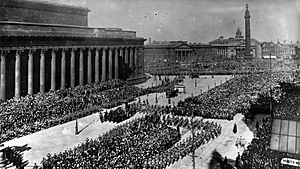
The King's Regiment had 49 battalions during the First World War. Before the war, it had only two regular, two special reserve, and six territorial battalions. Twenty-six of these battalions served abroad. The regiment earned 58 battle honours (recognitions for bravery in battle) and six Victoria Crosses. These were for service on the Western Front, in the Balkans, India, and Russia. About 13,795 soldiers from the King's Regiment died during the war. Thousands more were wounded, sick, or captured. The four Liverpool Pals battalions alone had nearly 2,800 casualties.

A strong recruiting campaign helped the British Army grow quickly. Lord Kitchener, the Secretary of State for War, asked for 100,000 volunteers. Lord Derby suggested forming a battalion of "Pals" for the King's Regiment. These "Pals" would be men from the same workplace or neighborhood. This idea was very successful. Thousands of men from Liverpool volunteered. They formed the 17th, 18th, 19th, and 20th Battalions. These were known as the "Liverpool Pals". Lord Derby told the recruits:
This should be a battalion of Pals, a battalion in which friends from the same office will fight shoulder to shoulder for the honour of Britain and the credit of Liverpool.
The 1st King's Battalion was based in Aldershot when the war started in August 1914. It sailed to France and landed on August 13. The battalion was part of the British Expeditionary Force (BEF). The BEF first fought the German Army at Mons, Belgium. After this, they retreated until September 5. The 1st King's helped protect other British units during this retreat.
The Allies stopped the German advance at the Marne. The battalion then moved north to Ypres, Belgium. In the First Battle of Ypres, the battalion captured the village of Molenaarelstoek. The Germans launched a big attack on November 11.
The 1st King's was one of the few units available to defend British lines. A large German force, including elite Prussian Guard soldiers, attacked. The 1st King's held their ground and almost destroyed the 3rd Prussian Foot Guards. By the end of the battle, the 1st King's had lost many soldiers. Their commanding officer was killed by a sniper.
By March 1915, eight battalions of the King's Regiment were on the Western Front. The 1st and 1/5th Battalions took part in an attack at Givenchy. The attack was meant to support another Allied offensive. However, the barbed wire defenses were not destroyed, which made it very hard for the 1st King's to advance. They suffered heavy casualties.
One month later, on April 24, the Germans started the Second Battle of Ypres. The 4th and 1/6th King's Battalions fought in this battle. The 4th King's had over 400 casualties in four days. Lance Corporal Tombs became the regiment's first Victoria Cross winner of the war. He helped wounded soldiers during the battle of Festubert. The 1/10th Battalion fought its first battle on June 16. They lost nearly 400 soldiers.
The British started a new offensive on September 25, at Loos. Eight battalions from the King's Regiment were involved. Chlorine gas was used on the first day. Strong winds blew the gas back, hurting the 1st King's. The 1/9th King's took about 300 German prisoners. More battalions arrived later in the year, including the Liverpool Pals.
Middle Years of the War (1916–1917)
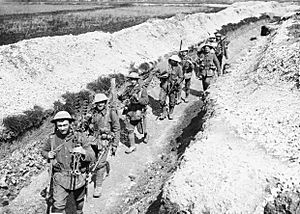
The Liverpool Pals fought their first battle on July 1, 1916. This was the first day of the Battle of the Somme. It was the worst single day for casualties in British military history. The Pals advanced with limited resistance and achieved their goals with fewer casualties than other units. However, the 18th Battalion suffered heavy losses from machine-gun fire.
More battalions joined the fighting during the Somme offensive. About 14 battalions took part in five attempts to capture the village of Guillemont. In the early hours of August 8, the 1st, 1/5th, and 1/8th Battalions attacked. The 1st and 1/8th reached the German trenches and entered the village. But they were surrounded and many were captured. The 1/8th Battalion was almost completely destroyed. The 1st Battalion also lost its commanding officer and many soldiers.
Captain Chavasse, a medical officer with the Liverpool Scottish, earned his first Victoria Cross. He helped and rescued wounded soldiers in "no man's land" (the area between enemy trenches). The village of Guillemont was finally captured on September 3. By then, the King's Regiment had over 3,000 casualties.
After the Somme Offensive ended in November, the Allies prepared for new attacks in April 1917. The German Army pulled back to a strong defensive line called the "Hindenburg Line". Six second-line battalions of the King's Regiment arrived on the Western Front in February 1917.
To support a French offensive, Britain started the Battle of the Scarpe on April 9. The 11th, 13th, and Liverpool Pals battalions of the King's Regiment were involved. The 13th Battalion captured almost 500 men and completed its objectives. The Liverpool Pals faced barbed wire, which caused heavy losses for some units. The King's Regiment had over 700 casualties in the first part of the Arras Offensive.
While the battle raged in Arras, the Allies prepared for an offensive in Flanders, Belgium. "Third Ypres" (also known as Passchendaele) became famous for its terrible conditions. The ground turned into a deep, sticky mud. Ten of the regiment's battalions fought in the first stage, the Battle of Pilkem Ridge. The territorial battalions reached their objectives, but progress was difficult. The King's Regiment suffered over 1,800 losses by August 3. Captain Chavasse, the medical officer, received a second Victoria Cross (after he died) for helping wounded soldiers despite his own injuries and tiredness. He died on August 4.
A soldier described the conditions at Ypres:
...Those who took part in it will never erase from their minds its many ghastly features, among which the mud and the multitude of dead will stand out pre-eminent. Of the former it must be said that the sodden condition of the ground, though it stopped our advance, certainly prevented many casualties from shell-fire, but at the same time many a wounded man was sucked down into the horrible quagmire and stretcher-bearers found their task in many cases beyond their powers.
Final Year of the War (1918)
The King's Regiment helped in the Battle of Cambrai in November 1917. Due to a shortage of soldiers, many battalions were combined or disbanded. The 5th, 8th, 9th, and 10th King's Battalions joined with their second-line units. The 20th Battalion was disbanded in February, and its soldiers were sent to other Liverpool Pals units.
Germany prepared for a final major attack before more American troops arrived. On March 21, a five-hour artillery and gas attack began the Battle of St. Quentin (Operation Michael). This was part of the German spring offensive in the Somme region. The 11th King's, though usually engineers, were in the front lines and suffered over 160 casualties. The Liverpool Pals, who were in reserve, rushed to the front on March 22 to launch counter-attacks. The 19th Battalion retook trenches but later came under heavy attack. Many were captured.
The situation became very bad, and troops had to retreat. The 1st King's Battalion was attacked on March 24 but held out until they were forced to retreat. Their commander had only 60 men left. On March 28, the offensive spread to Arras but was stopped by the Allies. Germany stopped the operation on April 5, having lost many soldiers. However, the German Army launched another attack in Flanders on April 9, called Operation Georgette. The Battle of the Lys began with a heavy bombardment. The King's Battalions fought hard and repelled frontal attacks. They also took up to 500 prisoners.
German forces made big gains, capturing Armentières. On April 11, British Commander-in-Chief Haig issued his famous "backs to the walls" order. Five days later, Private Counter of the 1st King's volunteered as a messenger. Five previous messengers had been killed. He was awarded the regiment's last Victoria Cross. The Allies eventually stabilized their front, and Operation Georgette ended on April 29. The Liverpool Pals fought in this final battle.
The German Army stopped its attacks in July. The 11th King's Battalion disbanded in April. The Liverpool Pals temporarily combined in May. In August, the Allies launched an offensive near Amiens. They surprised the Germans, taking over 16,000 prisoners in two hours. In the following Battle of Albert, the 13th King's suffered 274 casualties but captured 150 German soldiers. The 1st King's helped capture Ervillers.
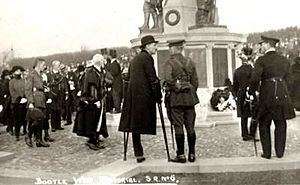
The war in Europe ended with the signing of the Armistice of 11 November 1918 on November 11, 1918. Soldiers reacted calmly to the news. The 9th Battalion's history said:
While on parade on the morning of the 11th November it was announced to the men that the Armistice had been signed. The news of the cessation of hostilities was received by the soldiers without any manifestation of the joy or excitement that marked the occasion at home. The parade continued and the rest of the day was spent quite as usual. The news for which the men had waited so long seemed when it came to be almost too good to be true.
On December 11, 1918, the 1st King's marched into Germany. They were part of the British Army of the Rhine. They stayed in Germany for about five months. Most battalions were disbanded by late 1919.
Between the World Wars (1918–1939)
Fighting did not end for the 17th King's on November 11. The battalion had sailed to Murmansk, Russia, in October. They were part of an Allied force helping "White" forces fight against the Bolsheviks in the civil war. The battalion's companies served separately until they left Russia in September 1919.
The Territorial Force was disbanded and later reformed as the Territorial Army. The regiment's battalions were also reformed. However, due to army reductions, the regiment had only one territorial battalion by 1937. The 8th Battalion disbanded. The 9th was absorbed by the Royal Engineers. Other battalions like the 6th, 7th, and 10th changed roles. The 6th became part of the Royal Engineers. The 7th joined the Royal Tank Regiment. The 10th became a battalion of the Queen's Own Cameron Highlanders.
1st King's Battalion
In 1920, during the Irish War of Independence, the 1st Battalion went to Bantry, Ireland. This area had a lot of Republican activity. The King's Regiment gained a good reputation for being professional and treating prisoners humanely. This reportedly saved the lives of some of their own soldiers. An IRA leader described their conduct as "exemplary". After Ireland became independent in the south, the battalion moved to Northern Ireland.
After a short time in Turkey, the battalion returned to England in 1924. They then served overseas again in 1926, in Malta, Sudan, and Egypt. While in Egypt, they sometimes dealt with riots. A company had to be sent to Jerusalem. In October 1931, Greek Cypriots in Cyprus demanded to join Greece. The battalion sent two companies to help the British garrison. The 1st King's next went to India in 1937, to the Khyber Pass. They continued to serve in the North-West Frontier Province into the Second World War.
2nd King's Battalion
The 2nd Battalion stayed in India after the First World War. They were called into action during the Third Anglo-Afghan War in 1919. The war ended before they could fight Afghan forces.
After most soldiers left the army in 1920, the remaining personnel joined the garrison in Sudan. The battalion then reformed. They were posted to Hong Kong and Canton in 1922, then to India in 1924, and finally to Iraq in 1925. They stayed near Baghdad for two years. They were the last British battalion to serve there until the Second World War.
After returning to England, the 2nd King's became the first battalion of the regiment to perform public duties at Buckingham Palace. They were based in different parts of the UK for almost ten years. In 1938, they became part of the Gibraltar garrison.
Second World War (1939–1945)
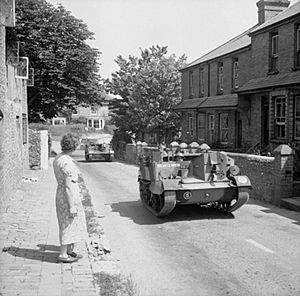
The King's Regiment grew during the Second World War, but not as much as in the First World War. Ten battalions were formed between 1939 and 1940. This included the 8th (Liverpool Irish) Battalion, which was brought back. Two battalions changed roles in 1941. The 11th became the 152nd Regiment in the Royal Armoured Corps (tank unit). The 12th became an anti-aircraft unit in the Royal Artillery.
By late 1941, three battalions (1st, 2nd, and 13th) were overseas. The others were ready to defend the UK from a possible German invasion. The 1st and 13th battalions served in Burma as Chindits (special forces). The 2nd fought in Italy and Greece. The 5th and 8th fought on the Western Front in Europe. The 9th Battalion, formed in 1939, served with the 55th Division. Of the battalions that changed roles, only the 40th RTR (7th King's) saw active service. They fought in the North African campaign, Italy, and Greece.
Fighting in Italy and Greece
The 2nd Battalion King's had been in Gibraltar for five years. In December 1943, they left to join the 4th Infantry Division in Egypt. The battalion landed in Italy in March 1944. On May 11, the division crossed the Gari River during the final Fourth Battle of Monte Cassino. The 2nd King's led the initial attack. They were behind schedule and lacked artillery support. Many boats overturned in the strong current, causing losses. The battalion suffered many casualties and its commanding officer was badly wounded. They had to retreat on May 14. The 2nd King's had 72 men killed or missing. After five months, Monte Cassino was captured on May 18.
The Allies captured Rome in June. The 2nd King's fought in the advance to the Trasimene Line. The King's captured Gioiella in a fierce battle. They later secured and defended Tuori against counter-attacks. This earned the regiment a special battle honor. In about nine months, the battalion earned many awards for bravery.
In December, the 4th Infantry Division went to Greece. They reinforced British forces in the country's civil war. After the Germans left, Communist fighters (ELAS) tried to take control. They fought against the British-supported government. Within 24 hours of arriving on December 12, the 2nd King's fought the partisans. They seized occupied barracks but lost 14 soldiers. They fought house-to-house and in the streets of Athens for seven weeks. By mid-January 1945, the city was clear. The King's stayed for a year to help keep the peace. They then left for Cyprus.
Fighting in Burma
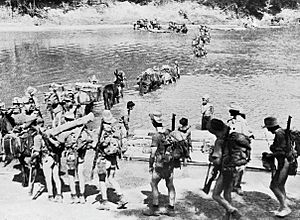
The 13th Battalion, King's Regiment, was formed in October 1940 for coastal defense in England. They sailed to India in December 1941, when Japan entered the war. The 13th Battalion was meant for security duties. Many of its soldiers were older or not fully trained. After Japan occupied Burma in 1942, the Allies formed a unit to go deep behind Japanese lines. This unit was called the "Chindits". The 13th King's provided most of the British soldiers for this group.
The Chindits' first operation began on February 8, 1943. The 13th King's formed five independent columns. They crossed the Chindwin River and advanced into Burma without meeting Japanese forces at first.
The 1st Battalion also took part in a similar operation in 1944. The Chindits again suffered heavy casualties. They fought behind Japanese lines at Kohima and Imphal. After their leader, Orde Wingate, died, some Chindit units became airborne infantry battalions. The 1st King's became the 15th (King's) Parachute Battalion. They joined the 77th Indian Parachute Brigade for the rest of the war.
Normandy and Germany
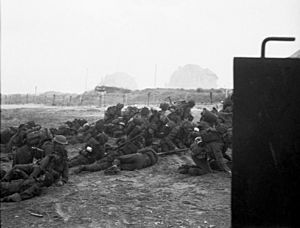
In 1943, the 5th and 8th King's (Liverpool Irish) received special training in Scotland. This was for the planned invasion of France. They were chosen to form "Beach Groups". Their job was to organize the beaches, secure positions, and defend against counter-attacks.
As the invasion neared in mid-1944, the two battalions moved to ports in southern England. They boarded troopships and landing ships. The invasion fleet sailed to Normandy on June 5. Both King's battalions landed on D-Day, June 6, 1944. The 5th Battalion landed at Sword, and the Liverpool Irish landed at Juno.
Two companies of the Liverpool Irish landed in the first wave. They faced intense machine gun and mortar fire. One company managed to set up a command post. However, another company faced heavy machine gun fire because reconnaissance and tanks arrived late. Many officers were wounded. At Sword Beach, the 5th King's tried to clear enemy positions and snipers. Their commanding officer was killed by a sniper.
Under fire, the beach groups collected the wounded and dead. They found and marked minefields. They also tried to keep things organized and direct vehicles and troops inland. The two battalions worked with the beach groups for six more weeks. The Liverpool Irish disbanded in August, with many of its soldiers sent to other units. The 5th King's survived as a smaller unit.
Before the Allies advanced into Nazi Germany in February 1945, special units were formed. Their job was to secure important things like equipment, intelligence, and personnel. The 5th King's formed the core of one such unit, No. 2 T (Target) Force. Elements of the 5th reached the naval port of Kiel in May 1945. They secured the German cruiser Admiral Hipper and took 7,000 sailors prisoner. The battalion continued to gather intelligence until it disbanded in July 1946. It was reformed in the Territorial Army in 1947.
After the Second World War (1945–1958)
The 1st King's, still a parachute battalion, remained in India. They were responsible for the area around Meerut. After changing back to standard infantry, the battalion returned to Liverpool in late 1947. In April 1948, the 2nd King's went to British Mandate of Palestine for two weeks. They carried out security duties before Israel was established. When the army reduced its size, the 2nd King's joined with the 1st Battalion. On September 6, 1948, the two battalions officially combined. The battalion was then posted to West Germany and later to West Berlin in February 1951.
Korean War (1950–1953)
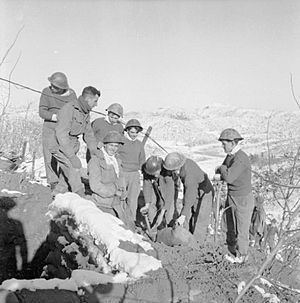
The battalion was sent to Korea in June 1952. By then, the Korean War was in a stalemate (a situation where neither side can win). It was mostly trench warfare. The King's soldiers sailed from Liverpool to Hong Kong, where they trained. They landed in Pusan, Korea, in September. The 1st King's took up defensive positions on the front line, about 45 miles from Seoul.
Most of the battalion's time at the front was quiet. However, their night patrols often clashed with Chinese troops. In 1953, the battalion moved to reserve for three months. A key area called "The Hook" (a crescent-shaped ridge) saw intense fighting in May. On the night of May 20, Chinese forces heavily shelled The Hook. Two days later, a company from the King's carried out a nighttime raid on Chinese positions called "Pheasant". During the raid, one platoon accidentally walked into a minefield. Ten soldiers were wounded. The attack had to be stopped.
The King's moved to the right side of The Hook on May 27. On May 28, a heavy artillery barrage began the battle. Chinese forces attacked in waves. Two King's platoons had to move forward to reinforce a position. After this attack was stopped, the Chinese focused on the King's on Point 146. The 1st King's called in artillery, tanks, and machine-gun fire. This destroyed the Chinese formation. Fighting continued until the British cleared The Hook. British casualties were 149, including 28 killed. Chinese losses were estimated at 250 killed and 800 wounded.
The 1st King's left Korea for Hong Kong in October. By then, the battalion had suffered 28 dead and 200 wounded. About 1,500 men served with the King's in Korea. Only 350 were regular soldiers; the rest were young men doing national service (compulsory military service). The King's moved to Britain in 1955, then to West Germany in 1956. They made their final return home in May 1958.
Regiment Joins Forces
The 1957 Defence White Paper announced that the army would reduce its size. Regiments would join together or be disbanded. The decision to merge the King's and Manchesters saddened many soldiers. However, the regiments had a historical link.
In June, the flags of the two regiments were paraded for the last time. The King's Regiment (Manchester and Liverpool) officially began on September 1, 1958. On July 1, 2006, this successor regiment joined with two others. They formed the Duke of Lancaster's Regiment.
The last territorial battalion of the King's (Liverpool), the 5th, kept its identity until 1967. Its history is now continued by "A" Company of the 4th Battalion, Duke of Lancaster's Regiment.
Regimental Museum
The King's Regiment Museum collection is displayed in the Museum of Liverpool.
Victoria Cross Heroes
The Victoria Cross is the highest award for bravery in the British military. Here are some of the heroes from the King's Regiment:
| Name | Battalion | Date | Location of Deed |
|---|---|---|---|
| Harry Hampton | 2nd | August 21, 1900 | Van Wyk's Vlei, South Africa |
| Henry James Knight | 1st | August 21, 1900 | Van Wyk's Vlei, South Africa |
| William Edward Heaton | 1st | August 23, 1900 | Geluk, South Africa |
| Joseph Harcourt Tombs | 1st | May 16, 1915 | Rue du Bois, France |
| Edward Felix Baxter | 1/8th (Irish) | April 17/18, 1916 | Blairville, France |
| Arthur Herbert Procter | 1/5th | June 4, 1916 | Ficheux, France |
| David Jones | 12th (Service) | September 3, 1916 | Guillemont, France |
| Oswald Austin Reid | 2nd | March 8/10, 1917 | Dialah River, Mesopotamia |
| Jack Thomas Counter | 1st | April 16, 1918 | Boisieux St. Marc, France |
Regimental Prayer
The Regimental Prayer of the King’s Regiment (Liverpool) was:
Lord Jesus, Wisdom of God, by whom kings reign and princes decree justice, look mercifully on thy servants of the King's Regiment, and so strengthen us that in hardships and dangers we may fear no evil, for thou art with us, who with the father and the Holy Ghost livest and reignest for ever. Amen
Images for kids


